Simulating the Impacts of Tree, C3, and C4 Plant Functional Types on the Future Climate of West Africa
Abstract
1. Introduction
2. Model, Data, and Methods
2.1. RegCM4.4-CLM4.5 Model Description
2.2. Data
2.3. Methods
2.3.1. Experimental Design with RegCM4.4
2.3.2. Assessment of Model Performance
3. Results and Discussion
3.1. RegCM4 Model Validation
3.2. Projected Future Climate over West Africa Using Prescribed and Dynamic Vegetation
3.3. Impact of Different Percentages of Trees, C3, and C4 PFTs Cover on the Future Climate of West Africa
4. Conclusions
Author Contributions
Funding
Acknowledgments
Conflicts of Interest
References
- Martin, R.M.; Kneeland, D.; Brooks, D.; Matta, R. State of the World ’s Forests; FAO: Rome, Italy, 2012; ISBN 978-92-5-107292-9. [Google Scholar]
- MacDicken, K.; Jonsson, Ö.; Piña, L.; Maulo, S.; Contessa, V.; Adikari, Y.; Garzuglia, M.; Lindquist, E.; Reams, G.; D’Annunzio, R. Global Forest Resources Assessment 2015: How Are the World’s Forests Changing? Food and Agriculture Organization of the United Nations: Rome, Italy, 2015. [Google Scholar]
- Zomer, R.J.; Trabucco, A.; Coe, R.D.; Place, F.; van Noordwijk, M.; Xu, J.C. Trees on farms: An update and reanalysis of agroforestry’s global extent and socio-ecological characteristics. World Agrofor. Cent. Work. Pap. 2014. [Google Scholar] [CrossRef]
- Neufeldt, H.; Wilkes, A.; Zomer, R.J.; Xu, J.; Nang’ole, E.; Munster, C.; Place, F. Trees on farms: Tackling the triple challenge of mitigation, adaptation and food security. World Agrofor. Cent. Policy 2009, 7, 1–6. [Google Scholar]
- Nair, P.K.R. Classification of agroforestry systems. Agrofor. Syst. 1985, 3, 97–128. [Google Scholar] [CrossRef]
- Harvey, C.A.; Komar, O.; Chazdon, R.; Ferguson, B.G.; Finegan, B.; Griffith, D.M.; Martínez-Ramos, M.; Morales, H.; Nigh, R.; Soto-Pinto, L.; et al. Integrating agricultural landscapes with biodiversity conservation in the Mesoamerican hotspot. Conserv. Biol. 2008, 22, 8–15. [Google Scholar] [CrossRef] [PubMed]
- Mbow, C.; Smith, P.; Skole, D.; Duguma, L.; Bustamante, M. Achieving mitigation and adaptation to climate change through sustainable agroforestry practices in africa. Curr. Opin. Environ. Sustain. 2014, 6, 8–14. [Google Scholar] [CrossRef]
- Bayala, J.; Sanou, J.; Teklehaimanot, Z.; Kalinganire, A.; Ouédraogo, S.J. Parklands for buffering climate risk and sustaining agricultural production in the Sahel of West Africa. Curr. Opin. Environ. Sustain. 2014, 6, 28–34. [Google Scholar] [CrossRef]
- Haile, S.G.; Nair, P.K.R.; Nair, V.D. Carbon storage of different soil-size fractions in Florida silvopastoral systems. J. Environ. Qual. 2008, 37, 1789–1797. [Google Scholar] [CrossRef] [PubMed]
- Nair, P.K.R.; Kumar, B.M.; Nair, V.D. Agroforestry as a strategy for carbon sequestration. J. Plant Nutr. Soil Sci. 2009, 172, 10–23. [Google Scholar] [CrossRef]
- Takimoto, A.; Nair, P.K.R.; Alavalapati, J.R.R. Socioeconomic potential of carbon sequestration through agroforestry in the West African Sahel. Mitig. Adapt. Strateg. Glob. Chang. 2008, 13, 745–761. [Google Scholar] [CrossRef]
- Takimoto, A.; Nair, P.K.R.; Nair, V.D. Carbon stock and sequestration potential of traditional and improved agroforestry systems in the West African Sahel. Agric. Ecosyst. Environ. 2008, 125, 159–166. [Google Scholar] [CrossRef]
- Luedeling, E.; Neufeldt, H. Carbon sequestration potential of parkland agroforestry in the Sahel. Clim. Chang. 2012, 115, 443–461. [Google Scholar] [CrossRef]
- Mbow, C.; Van Noordwijk, M.; Luedeling, E.; Neufeldt, H.; Minang, P.A.; Kowero, G. Agroforestry solutions to address food security and climate change challenges in Africa. Curr. Opin. Environ. Sustain. 2014, 6, 61–67. [Google Scholar] [CrossRef]
- United Nations Framework Convention on Climate Change (UNFCCC). Options for Possible Additional Land Use, Land-Use Change and Forestry Activities and Alternative Approaches to Addressing the Risk of Non-Permanence under the Clean Development Mechanism; Technical Paper; UNFCCC: New York, NY, USA, 2014; pp. 1–18. [Google Scholar]
- Dixon, R.K. Agroforestry systems: Sources of sinks of greenhouse gases? Agrofor. Syst. 1995, 31, 99–116. [Google Scholar] [CrossRef]
- Smith, P.; Clark, H.; Dong, H.; Elsiddig, E.A.; Haberl, H.; Harper, R.; House, J.; Jafari, M.; Masera, O.; Mbow, C.; et al. Climate Change 2014: Mitigation of Climate Change. Contribution of Working Group III to the Fifth Assessment Report of the Intergovernmental Panel on Climate Change; Agriculture, Forestry and Other Land Use (AFOLU); Cambridge University Press: Cambridge, UK, 2014. [Google Scholar]
- Abiodun, B.J.; Adeyewa, Z.D.; Oguntunde, P.G.; Salami, A.T.; Ajayi, V.O. Modeling the impacts of reforestation on future climate in West Africa. Theor. Appl. Climatol. 2012, 110, 77–96. [Google Scholar] [CrossRef]
- Abiodun, B.J.; Salami, A.T.; Matthew, O.J.; Odedokun, S. Potential impacts of afforestation on climate change and extreme events in Nigeria. Clim. Dyn. 2013, 41, 277–293. [Google Scholar] [CrossRef]
- Chen, G.S.; Notaro, M.; Liu, Z.; Liu, Y. Simulated local and remote biophysical effects of afforestation over the Southeast United States in boreal summer. J. Clim. 2012, 25, 4511–4522. [Google Scholar] [CrossRef]
- Gálos, B.; Mátyás, C.; Jacob, D. Regional characteristics of climate change altering effects of afforestation. Environ. Res. Lett. 2011, 6, 44010. [Google Scholar] [CrossRef]
- Swann, A.L.S.; Fung, I.Y.; Chiang, J.C.H. Mid-latitude afforestation shifts general circulation and tropical precipitation. Proc. Natl. Acad. Sci. USA 2012, 109, 712–716. [Google Scholar] [CrossRef] [PubMed]
- Charney, J.; Quirk, W.J.; Chow, S.-H.; Kornfield, J. A comparative study of the effects of albedo change on drought in semi-arid regions. J. Atmos. Sci. 1977, 34, 1366–1385. [Google Scholar] [CrossRef]
- Zheng, X.; Eltahir, E.A.B. The response to deforestation and desertification in a model of West African monsoons. Geophys. Res. Lett. 1997, 24, 155–158. [Google Scholar] [CrossRef]
- Zheng, X.; Eltahir, E.A.B. The role of vegetation in the dynamics of West African monsoons. J. Clim. 1998, 11, 2078–2096. [Google Scholar] [CrossRef]
- Collins, M.; Knutti, R.; Arblaster, J.; Dufresne, J.-L.; Fichefet, T.; Friedlingstein, P.; Gao, X.; Gutowski, W.J.; Johns, T.; Krinner, G.; et al. Long-term Climate Change: Projections, Commitments and Irreversibility. In Climate Change 2013: The Physical Science Basis. IPCC Working Group I Contribution to AR5; Cambridge University Press: Cambridge, UK; New York, NY, USA, 2013; pp. 1029–1136. [Google Scholar] [CrossRef]
- Xue, Y. Biosphere feedback on regional climate in tropical North Africa. Q. J. R. Meteorol. Soc. 1997, 123, 1483–1515. [Google Scholar] [CrossRef]
- Zeng, N.; Neelin, J.D. A Land-Atmosphere Interaction Theory for the Tropical Deforestation Problem. J. Clim. 1999, 12, 857–872. [Google Scholar] [CrossRef]
- Olusegun, C.; Adeyewa, Z. Spatial and Temporal Variation of Normalized Difference Vegetation Index (NDVI) and Rainfall in the North East Arid Zone of Nigeria. Atmos. Clim. Sci. 2013, 3, 421–426. [Google Scholar] [CrossRef]
- Alo, C.A.; Wang, G. Role of dynamic vegetation in regional climate predictions over Western Africa. Clim. Dyn. 2010, 35, 907–922. [Google Scholar] [CrossRef]
- Oguntunde, P.G.; Abiodun, B.J.; Lischeid, G.; Merz, C. Modelling the impacts of reforestation on the projected hydroclimatology of Niger River Basin, West Africa. Ecohydrology 2014, 7, 163–176. [Google Scholar] [CrossRef]
- Sage, R.F.; Li, M.M.R. The Taxonomic Distribution of C4 Photosynthesis; Academic Press: San Diego, CA, USA, 1999. [Google Scholar]
- Levis, S.; Gordon, B.B.; Kluzek, E.; Thornton, P.E.; Jones, A.; Sacks, W.J.; Kucharik, C.J. Interactive Crop Management in the Community Earth System Model (CESM1): Seasonal influences on land-atmosphere fluxes. J. Clim. 2012, 25, 4839–4859. [Google Scholar] [CrossRef]
- Oleson, K.; Lawrence, D.M.; Authors, L.; Bonan, G.B.; Drewniak, B.; Huang, M.; Koven, C.D.; Levis, S.; Li, F.; Riley, W.J.; et al. Technical Description of Version 4.5 of the Community Land Model (CLM); National Center for Atmospheric Research: Boulder, CO, USA, 2013. [Google Scholar]
- Yu, M.; Wang, G.; Pal, J.S. Effects of vegetation feedback on future climate change over West Africa. Clim. Dyn. 2015. [Google Scholar] [CrossRef]
- Wang, G.; Yu, M.; Pal, J.S.; Mei, R.; Bonan, G.B.; Levis, S.; Thornton, P.E. On the development of a coupled regional climate-vegetation model RCM–CLM–CN–DV and its validation in Tropical Africa. Clim. Dyn. 2015. [Google Scholar] [CrossRef]
- Gu, H.; Wang, G.; Yu, Z.; Mei, R. Assessing future climate changes and extreme indicators in east and south Asia using the RegCM4 regional climate model. Clim. Chang. 2012, 114, 301–317. [Google Scholar] [CrossRef]
- Adeniyi, M.O. Sensitivity of different convection schemes in RegCM4.0 for simulation of precipitation during the Septembers of 1989 and 1998 over West Africa. Theor. Appl. Climatol. 2014, 115, 305–322. [Google Scholar] [CrossRef]
- Oh, S.-G.; Park, J.-H.; Lee, S.-H.; Suh, M.-S. Assessment of the RegCM4 over East Asia and future precipitation change adapted to the RCP scenarios. J. Geophys. Res. Atmos. 2014, 119, 2913–2927. [Google Scholar] [CrossRef]
- Wang, X.; Yang, M.; Pang, G. Influences of Two Land-Surface Schemes on RegCM4 Precipitation Simulations over the Tibetan Plateau. Adv. Meteorol. 2015, 2015, 1–12. [Google Scholar] [CrossRef]
- Pal, J.S.; Giorgi, F.; Bi, X.; Elguindi, N.; Solmon, F.; Rauscher, S.A.; Gao, X.; Francisco, R.; Zakey, A.; Winter, J.; et al. Regional climate modeling for the developing world: The ICTP RegCM3 and RegCNET. Bull. Am. Meteorol. Soc. 2007, 88, 1395–1409. [Google Scholar] [CrossRef]
- Giorgi, F.; Coppola, E.; Solmon, F.; Mariotti, L.; Sylla, M.B.; Bi, X.; Elguindi, N.; Diro, G.T.; Nair, V.; Giuliani, G.; et al. RegCM4: Model description and preliminary tests over multiple CORDEX domains. Clim. Res. 2012, 52, 7–29. [Google Scholar] [CrossRef]
- Emanuel, K.A.; Živković-Rothman, M. Development and evaluation of a convection scheme for use in climate models. J. Atmos. Sci. 1999, 56, 1766–1782. [Google Scholar] [CrossRef]
- Grell, G.A. Prognostic evaluation of assumptions used by cumulus parameterizations. Mon. Weather Rev. 1993, 121, 764–787. [Google Scholar] [CrossRef]
- Davis, N.; Bowden, J.; Semazzi, F.; Xie, L.; Önol, B. Customization of RegCM3 regional climate model for eastern Africa and a tropical Indian Ocean domain. J. Clim. 2009, 22, 3595–3616. [Google Scholar] [CrossRef]
- Lawrence, P.J.; Chase, T.N. Representing a new MODIS consistent land surface in the Community Land Model (CLM 3.0). J. Geophys. Res. Biogeosci. 2007, 112. [Google Scholar] [CrossRef]
- Castillo, C.K.G.; Levis, S.; Thornton, P. Evaluation of the New CNDV Option of the Community Land Model: Effects of Dynamic Vegetation and Interactive Nitrogen on CLM4 Means and Variability. J. Clim. 2012, 25, 3702–3714. [Google Scholar] [CrossRef]
- Lawrence, D.M.; Oleson, K.W.; Flanner, M.G.; Thornton, P.E.; Swenson, S.C.; Lawrence, P.J.; Zeng, X.; Yang, Z.-L.; Levis, S.; Sakaguchi, K.; Bonan, G.B.; Slater, A.G.; et al. Parameterization improvements and functional and structural advances in version 4 of the Community Land Model. J. Adv. Model. Earth Syst. 2011, 3, 1–27. [Google Scholar] [CrossRef]
- Giorgi, F.; Jones, C.; Asrar, G.R. Addressing climate information needs at the regional level: The CORDEX framework. World Meteorol. Org. Bull. 2009, 58, 175. [Google Scholar]
- Browne, N.A.K.; Sylla, M.B. Regional climate model sensitivity to domain size for the simulation of the West African summer monsoon rainfall. Int. J. Geophys. 2012, 2012. [Google Scholar] [CrossRef]
- Rauscher, S.A.; Seth, A.; Qian, J.-H.; Camargo, S.J. Domain choice in an experimental nested modeling prediction system for South America. Theor. Appl. Clim. 2006, 86, 229–246. [Google Scholar] [CrossRef][Green Version]
- Zeng, X.; Zhao, M.; Dickinson, R.E. Intercomparison of bulk aerodynamic algorithms for the computation of sea surface fluxes using TOGA COARE and TAO data. J. Clim. 1998, 11, 2628–2644. [Google Scholar] [CrossRef]
- Harris, I.; Jones, P.D.; Osborn, T.J.; Lister, D.H. Updated high-resolution grids of monthly climatic observations—The CRU TS3.10 Dataset. Int. J. Climatol. 2014, 34, 623–642. [Google Scholar] [CrossRef]
- Dee, D.P.; Uppala, S.M.; Simmons, A.J.; Berrisford, P.; Poli, P.; Kobayashi, S.; Andrae, U.; Balmaseda, M.A.; Balsamo, G.; Bauer, P.; et al. The ERA-Interim reanalysis: Configuration and performance of the data assimilation system. Q. J. R. Meteorol. Soc. 2011, 137, 553–597. [Google Scholar] [CrossRef]
- Muthuri, C.W.; Ong, C.K.; Black, C.R.; Mati, B.M.; Ngumi, V.W.; van Noordwijk, M. Modelling the effects of leafing phenology on growth and water use by selected agroforestry tree species in semi-arid Kenya. Land Use Water Resour. Res. 2002, 4, 11. [Google Scholar]
- Angelo, C.L.; Daehler, C.C. Upward expansion of fire-adapted grasses along a warming tropical elevation gradient. Ecography 2013, 36, 551–559. [Google Scholar] [CrossRef]
- Ehleringer, J.R.; Sage, R.; Flanagan, L.; Pearcy, R. Climate change and evolution of C4 Photosynthesis. Land Use Water Resour. Res. 2002, 4, 11. [Google Scholar] [CrossRef]
- Afiesimama, E.A.; Pal, J.S.; Abiodun, B.J.; Gutowski, W.J.; Adedoyin, A. Simulation of West African monsoon using the RegCM3. Part I: Model validation and interannual variability. Theor. Appl. Climatol. 2006, 86, 23–37. [Google Scholar] [CrossRef]
- Le Barbé, L.; Lebel, T.; Tapsoba, D. Rainfall variability in West Africa during the years 1950–1990. J. Clim. 2002, 15, 187–202. [Google Scholar] [CrossRef]
- Sylla, M.B.; Coppola, E.; Mariotti, L.; Giorgi, F.; Ruti, P.M.; Dell’Aquila, A.; Bi, X. Multiyear simulation of the African climate using a regional climate model (RegCM3) with the high resolution ERA-interim reanalysis. Clim. Dyn. 2010, 35, 231–247. [Google Scholar] [CrossRef]
- Nikulin, G.; Jones, C.; Giorgi, F.; Asrar, G.; Büchner, M.; Cerezo-Mota, R.; Christensen, O.B.; Déqué, M.; Fernandez, J.; Hänsler, A.; et al. Precipitation climatology in an ensemble of CORDEX-Africa regional climate simulations. J. Clim. 2012, 25, 6057–6078. [Google Scholar] [CrossRef]
- Sylla, M.B.; Diallo, I.; Pal, J.S. West African monsoon in state-of-the-science regional climate models. In Climate Variability-Regional and Thematic Patterns; InTech: Rijeka, Croatia, 2013. [Google Scholar]
- Gbobaniyi, E.; Sarr, A.; Sylla, M.B.; Diallo, I.; Lennard, C.; Dosio, A.; Dhiédiou, A.; Kamga, A.; Klutse, N.A.B.; Hewitson, B.; et al. Climatology, annual cycle and interannual variability of precipitation and temperature in CORDEX simulations over West Africa. Int. J. Climatol. 2014, 34, 2241–2257. [Google Scholar] [CrossRef]
- Klutse, N.A.B.; Sylla, M.B.; Diallo, I.; Sarr, A.; Dosio, A.; Diedhiou, A.; Kamga, A.; Lamptey, B.; Ali, A.; Gbobaniyi, E.O.; et al. Daily characteristics of West African summer monsoon precipitation in CORDEX simulations. Theor. Appl. Climatol. 2015. [Google Scholar] [CrossRef]
- Bergant, K.; Belda, M.; Halenka, T. Systematic errors in the simulation of European climate (1961–2000) with RegCM3 driven by NCEP/NCAR reanalysis. Int. J. Climatol. 2007, 27, 455–472. [Google Scholar] [CrossRef]
- Rockel, B.; Geyer, B. The performance of the regional climate model CLM in different climate regions, based on the example of precipitation. Meteorol. Z. 2008, 17, 487–498. [Google Scholar] [CrossRef]
- Druyan, L.M.; Feng, J.; Cook, K.H.; Xue, Y.; Fulakeza, M.; Hagos, S.M.; Konaré, A.; Moufouma-Okia, W.; Rowell, D.P.; Vizy, E.K.; et al. The WAMME regional model intercomparison study. Clim. Dyn. 2010, 35, 175–192. [Google Scholar] [CrossRef]
- Thorncroft, C.D.; Blackburn, M. Maintenance of the African easterly jet. Q. J. R. Meteorol. Soc. 1999, 125, 763–786. [Google Scholar] [CrossRef]
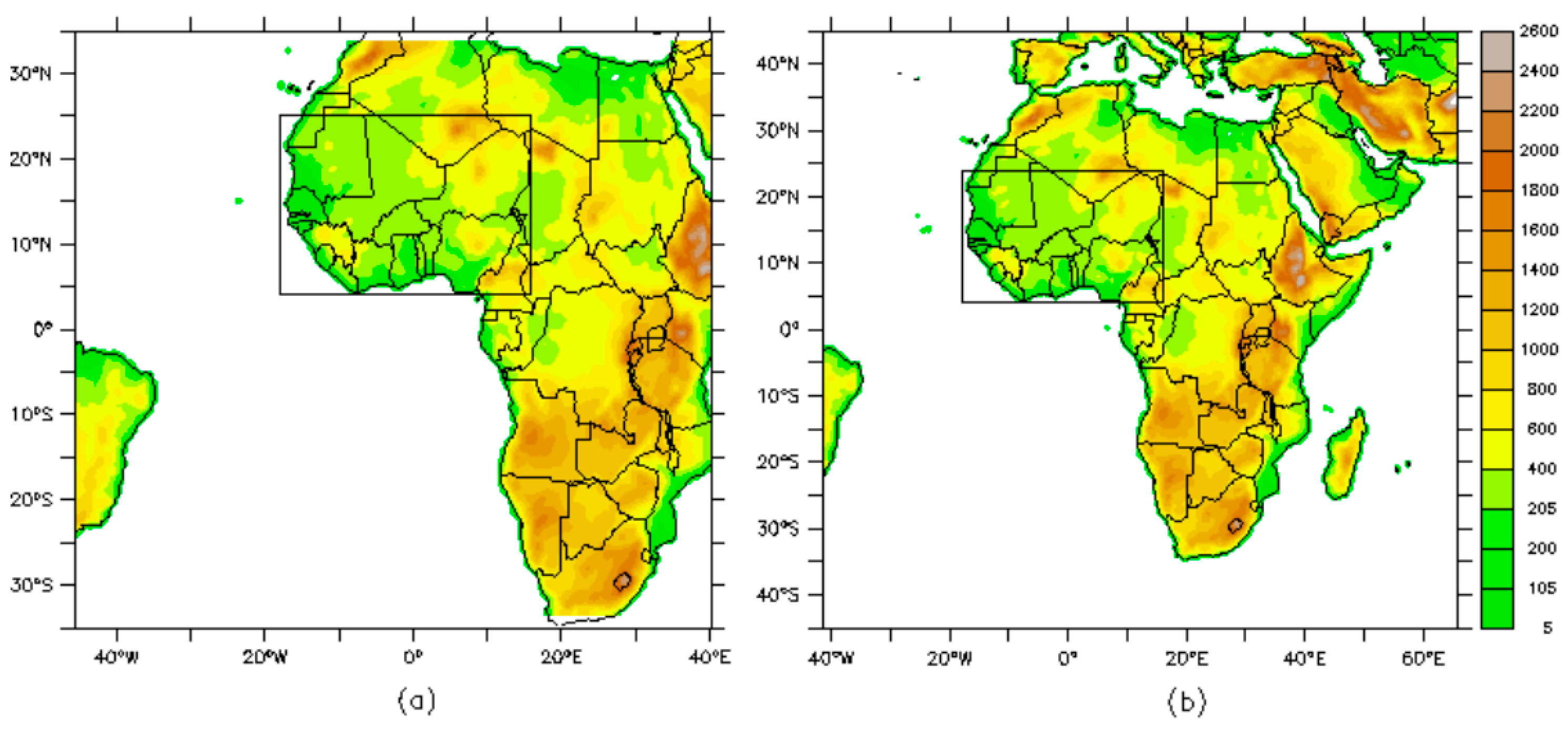
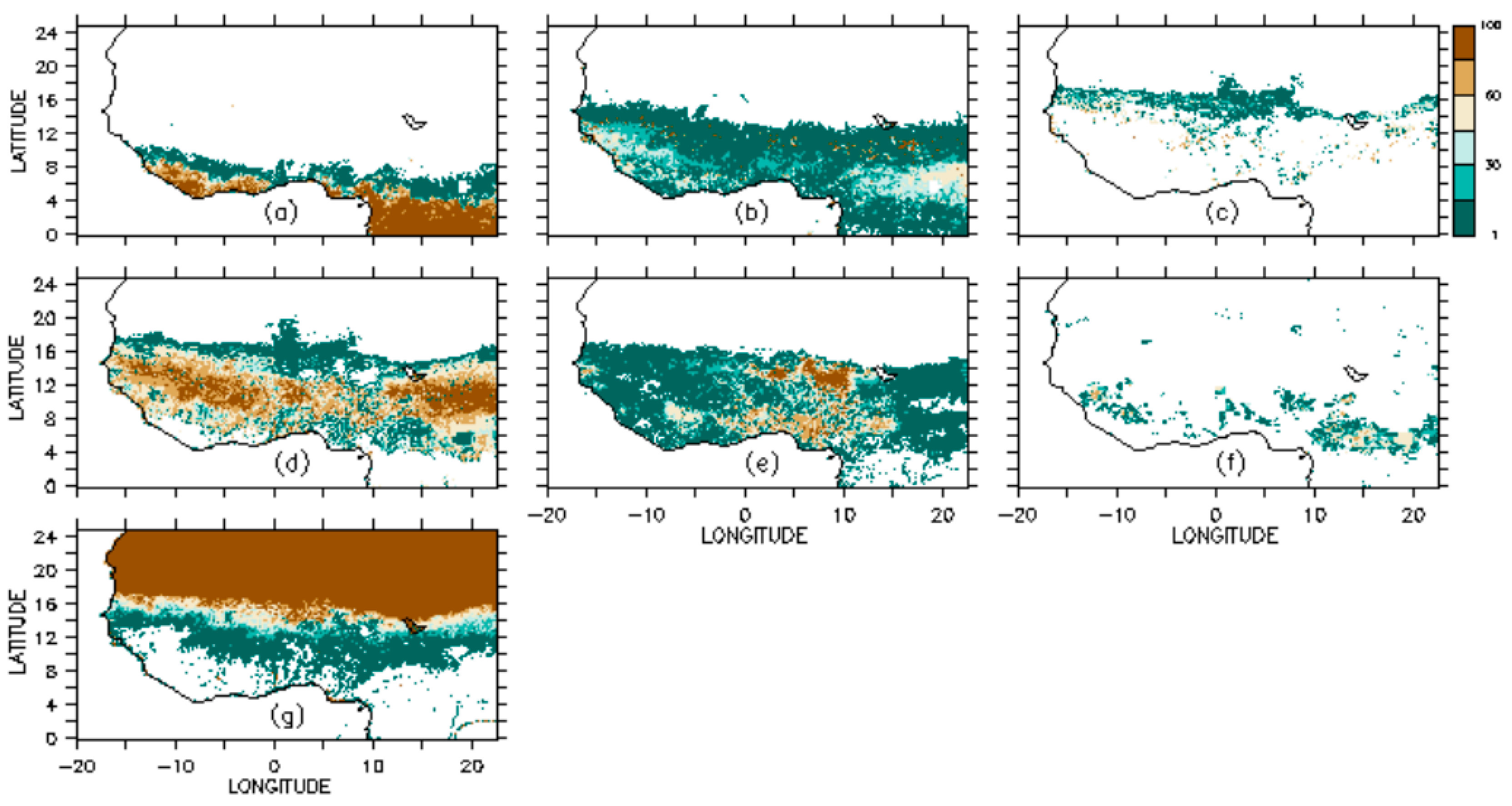
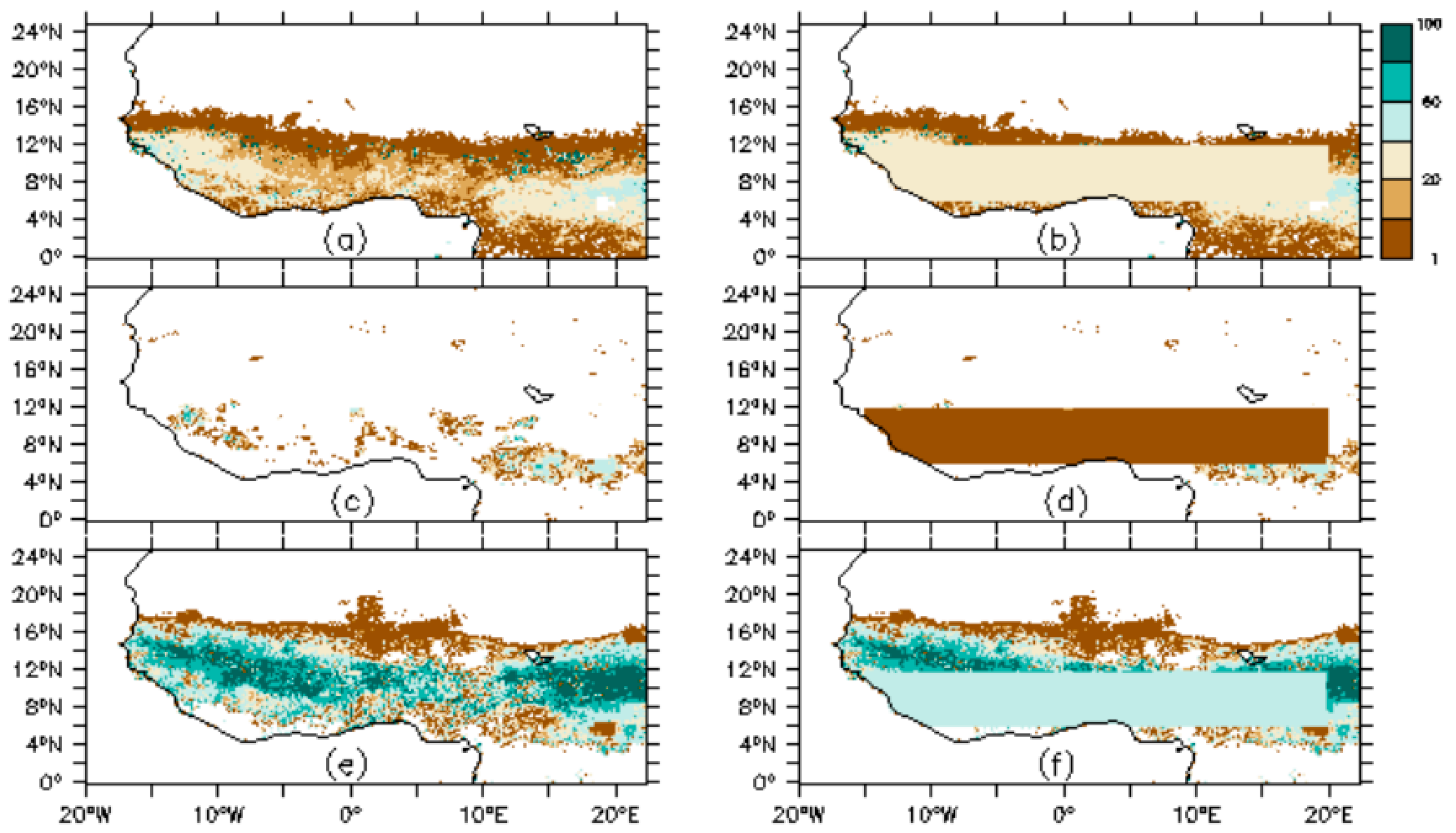
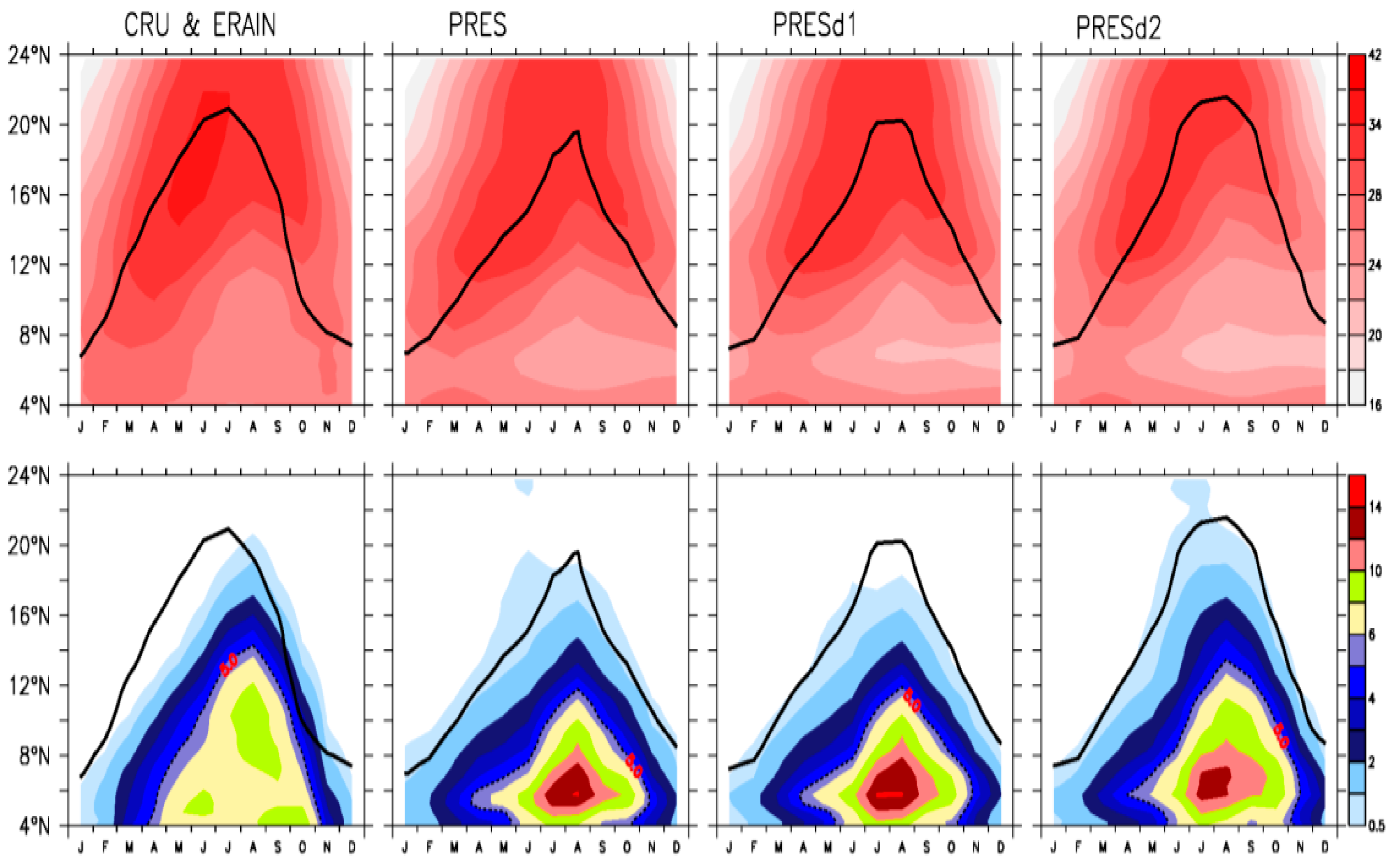
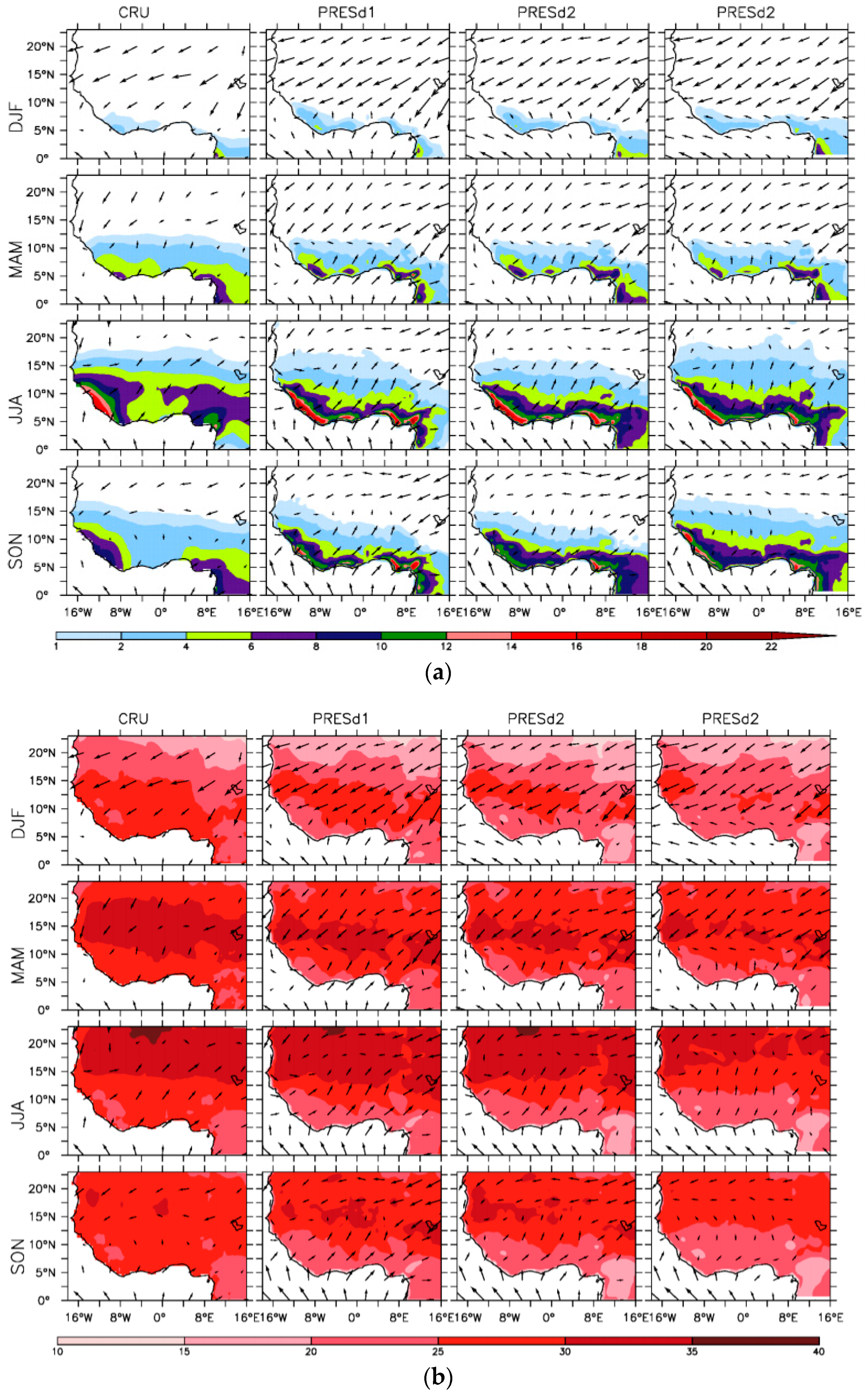
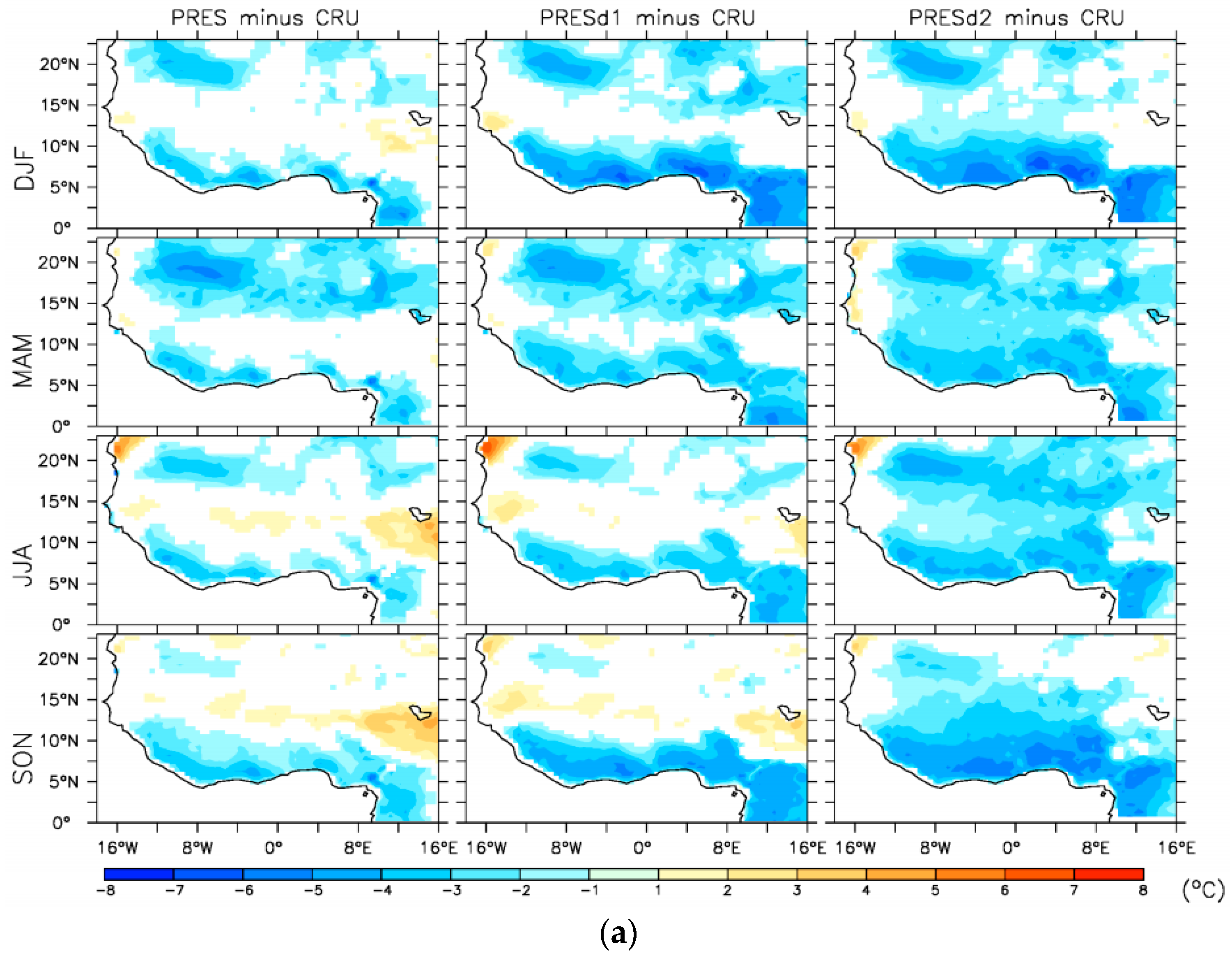

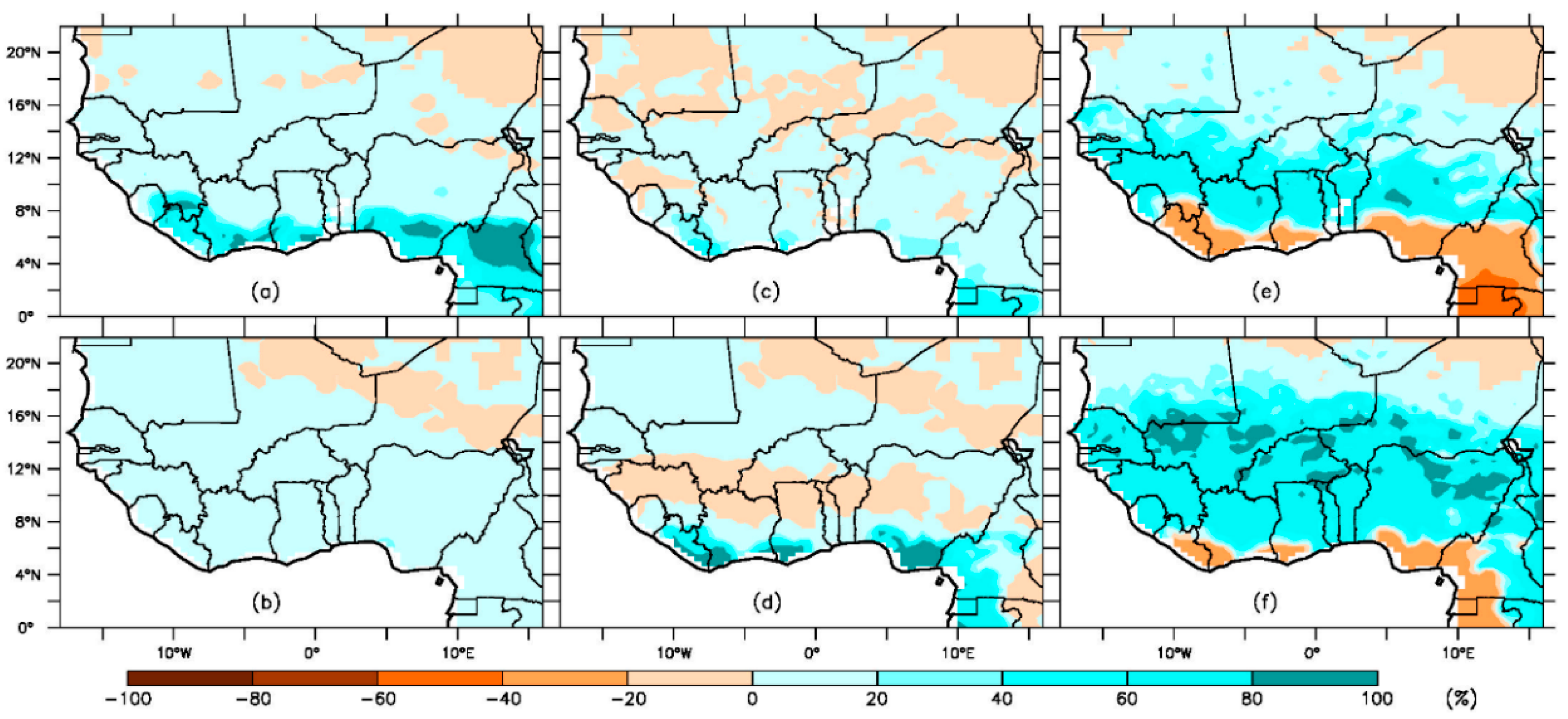
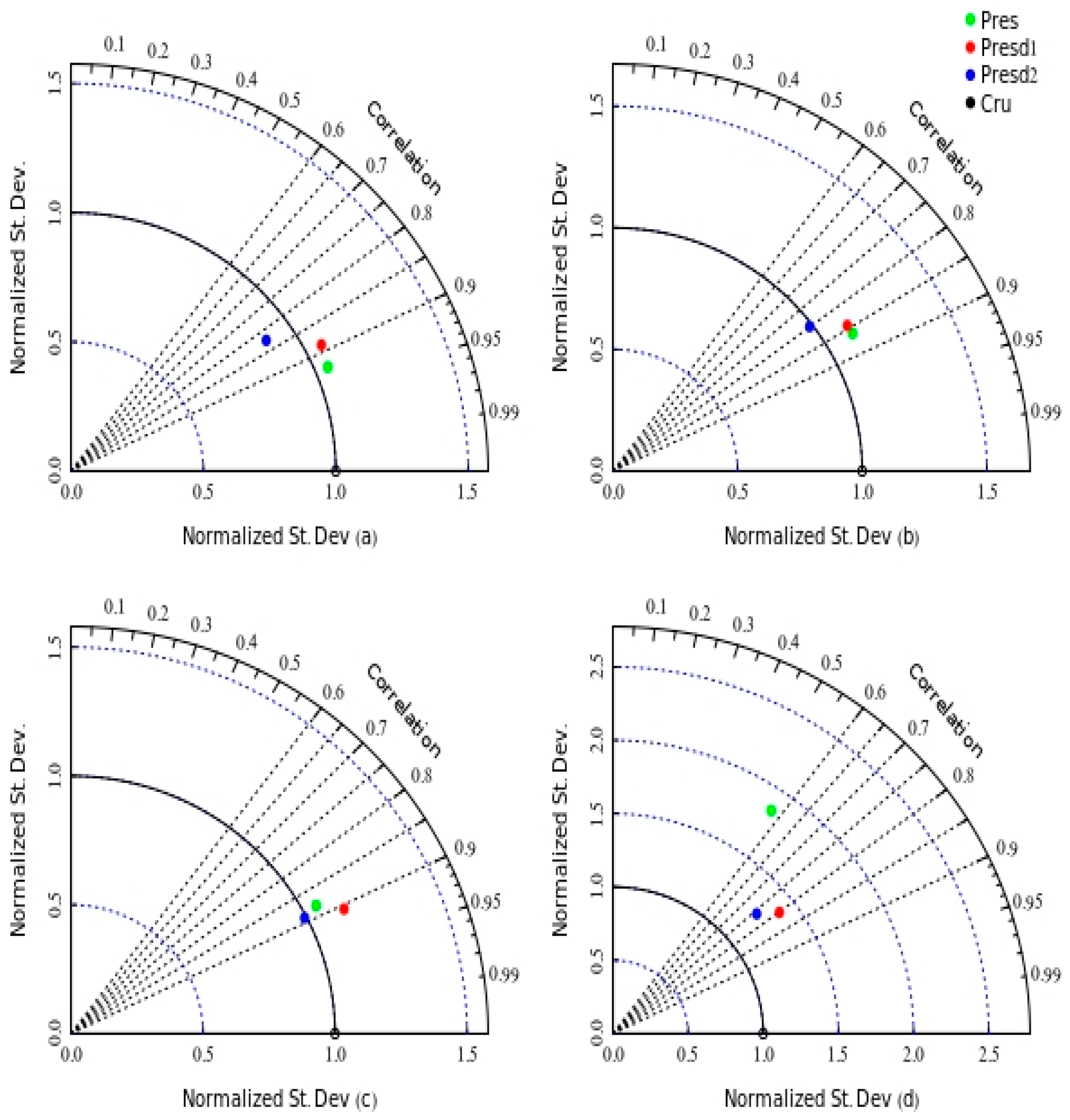
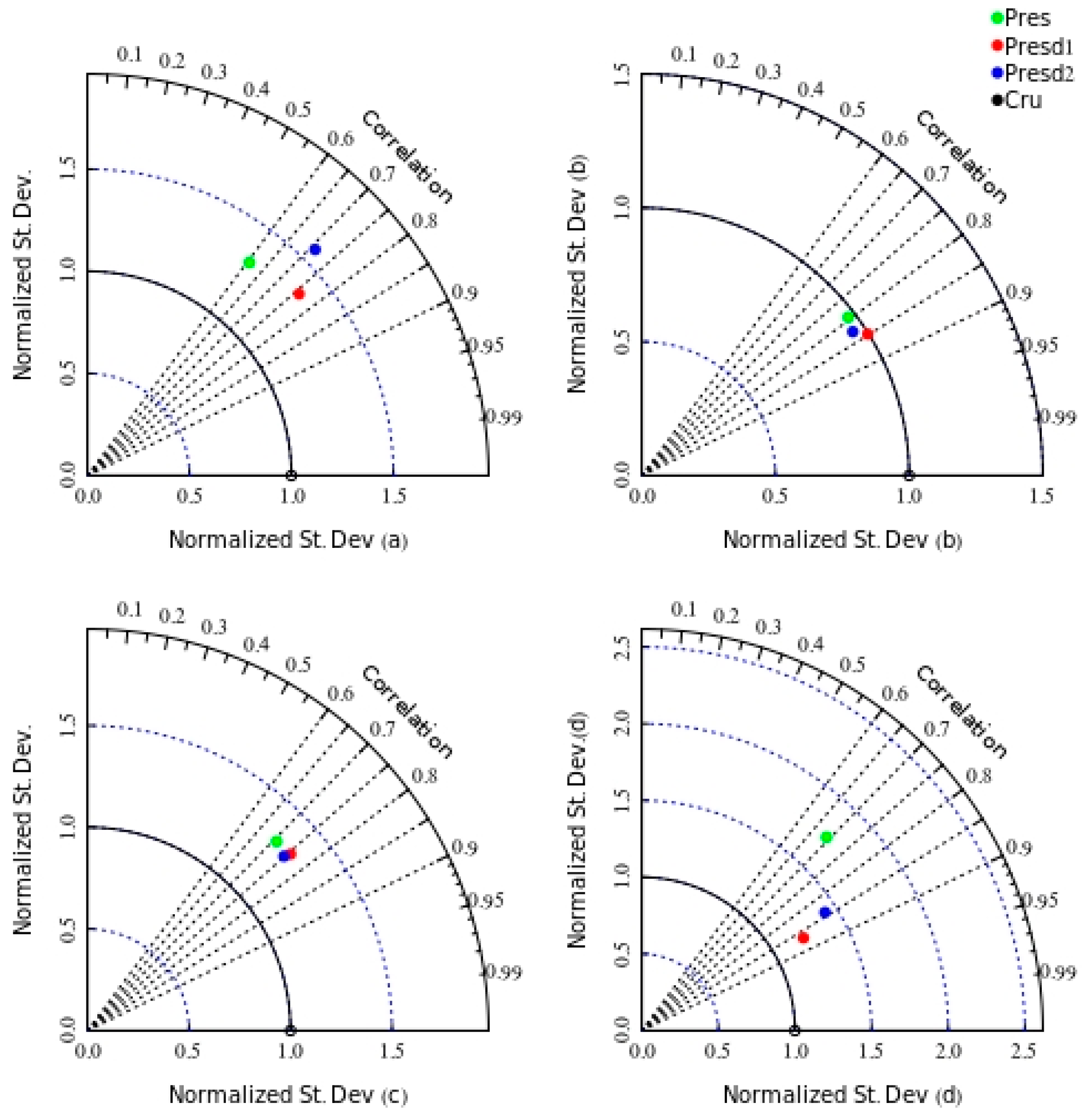
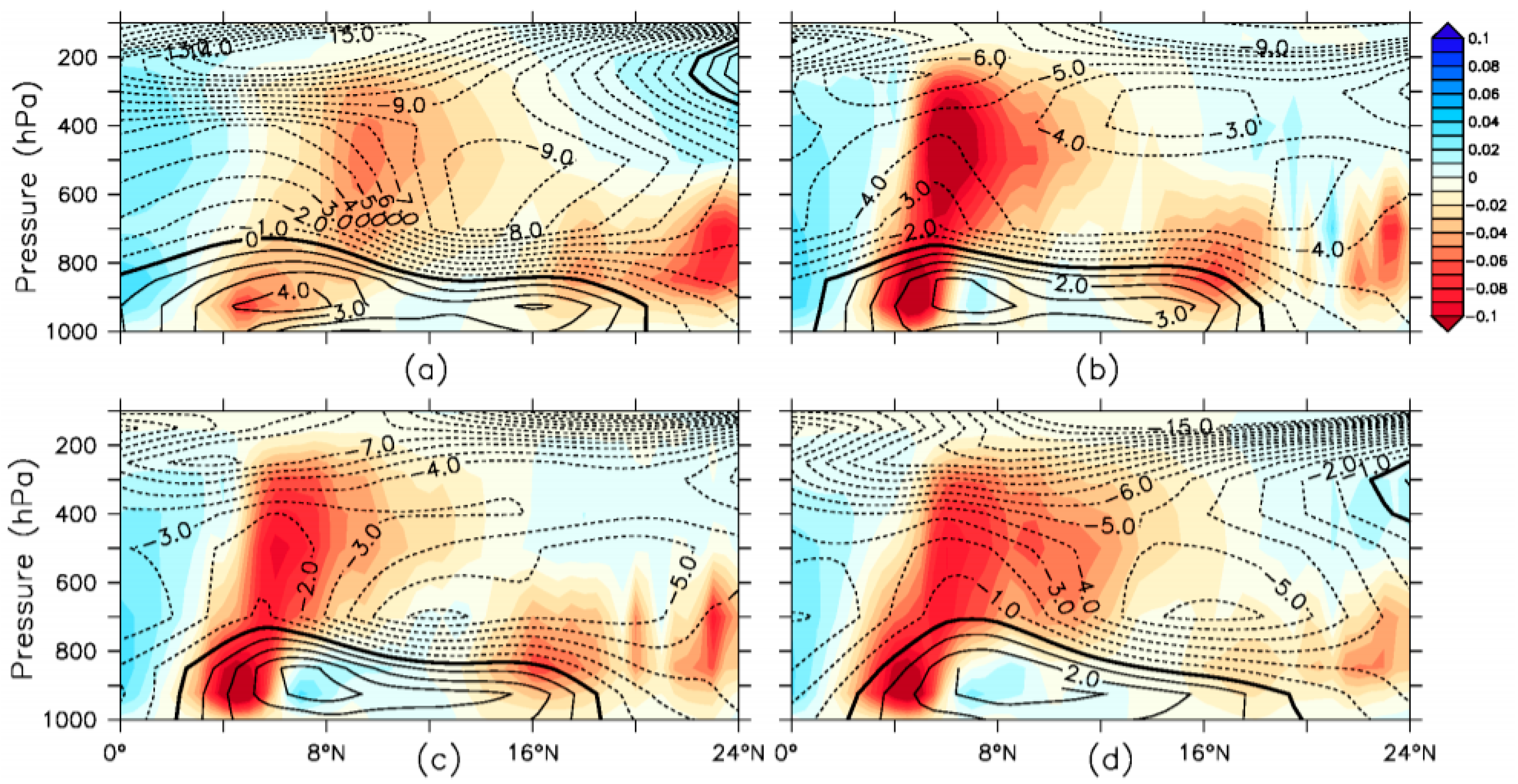


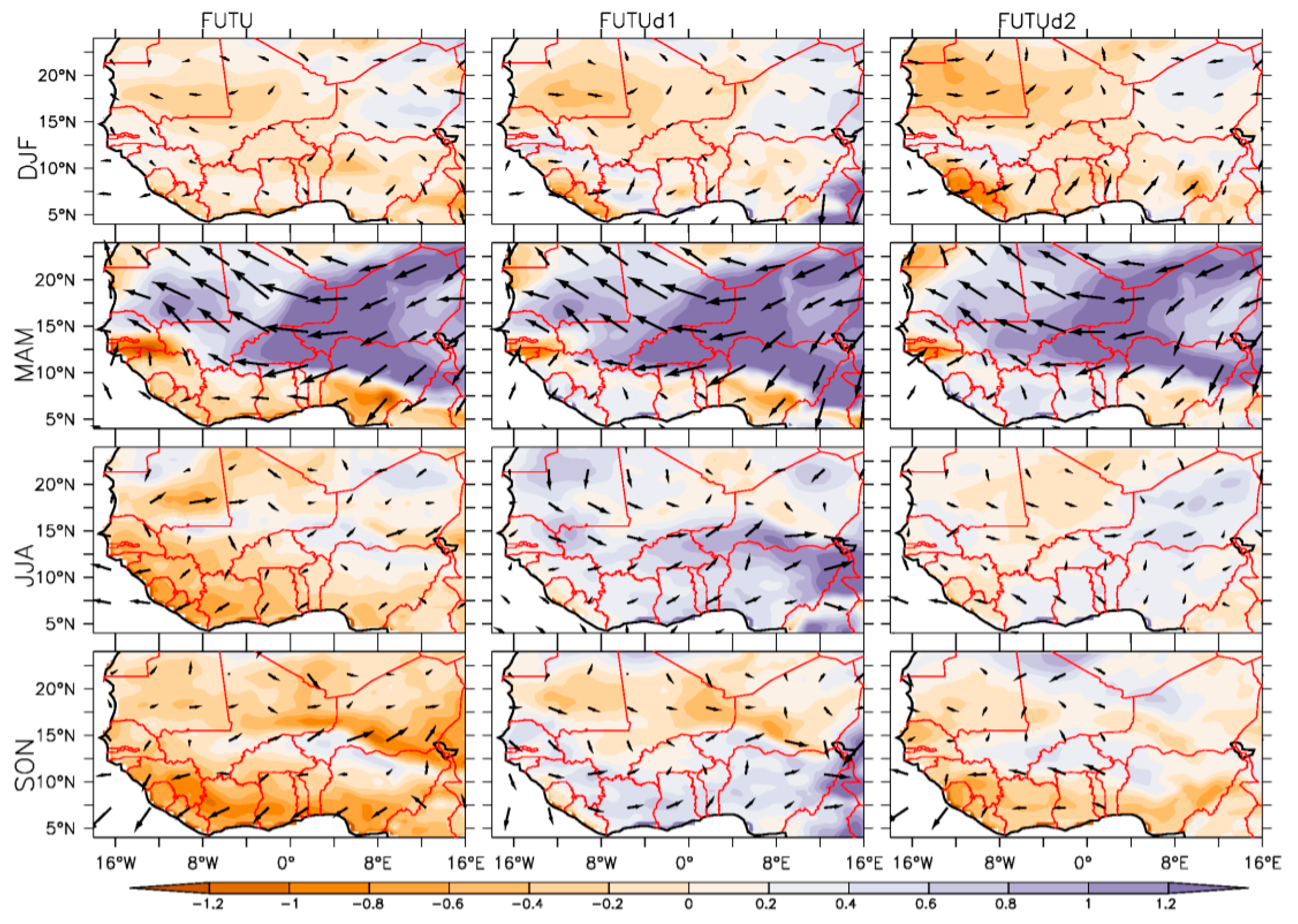
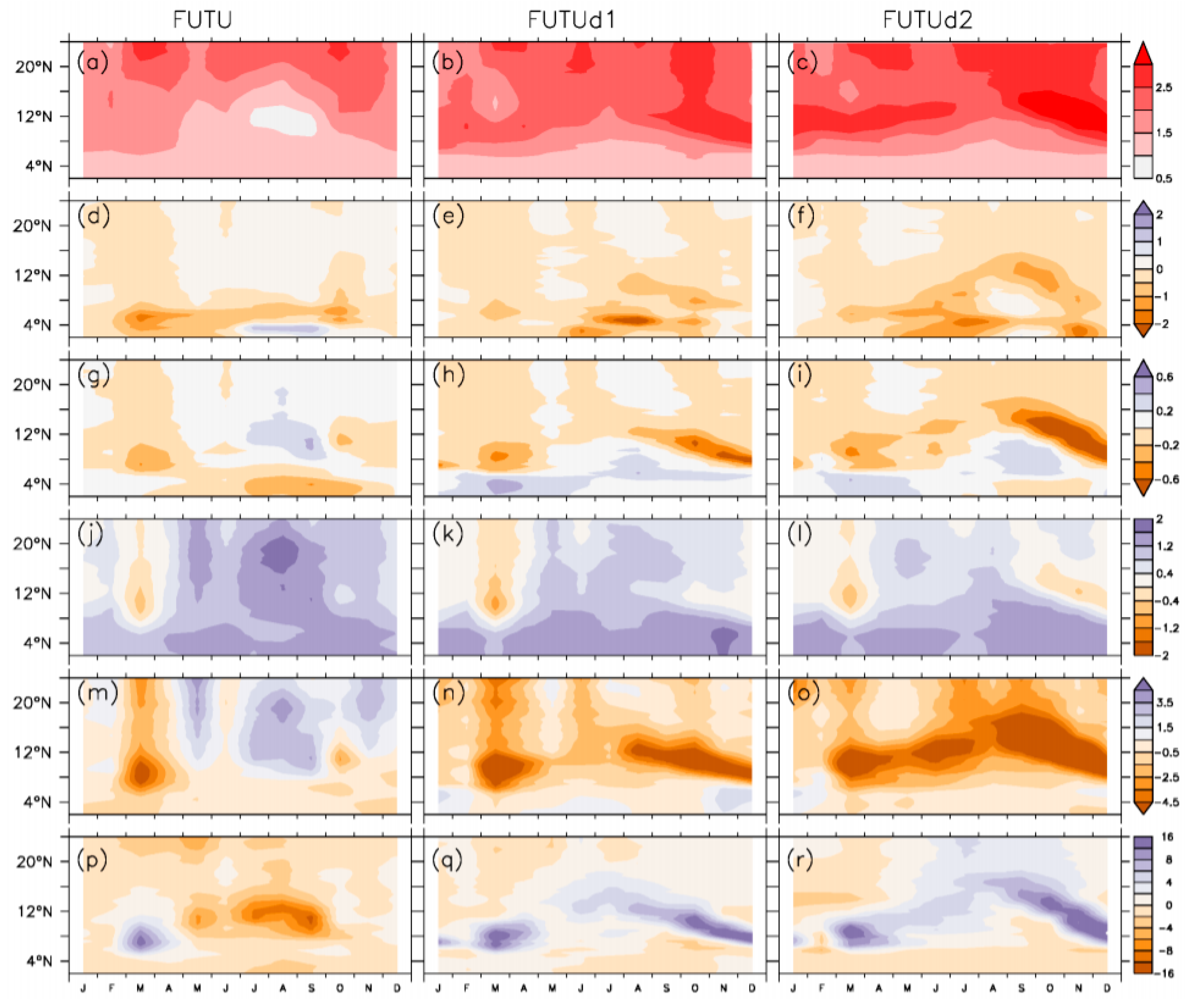

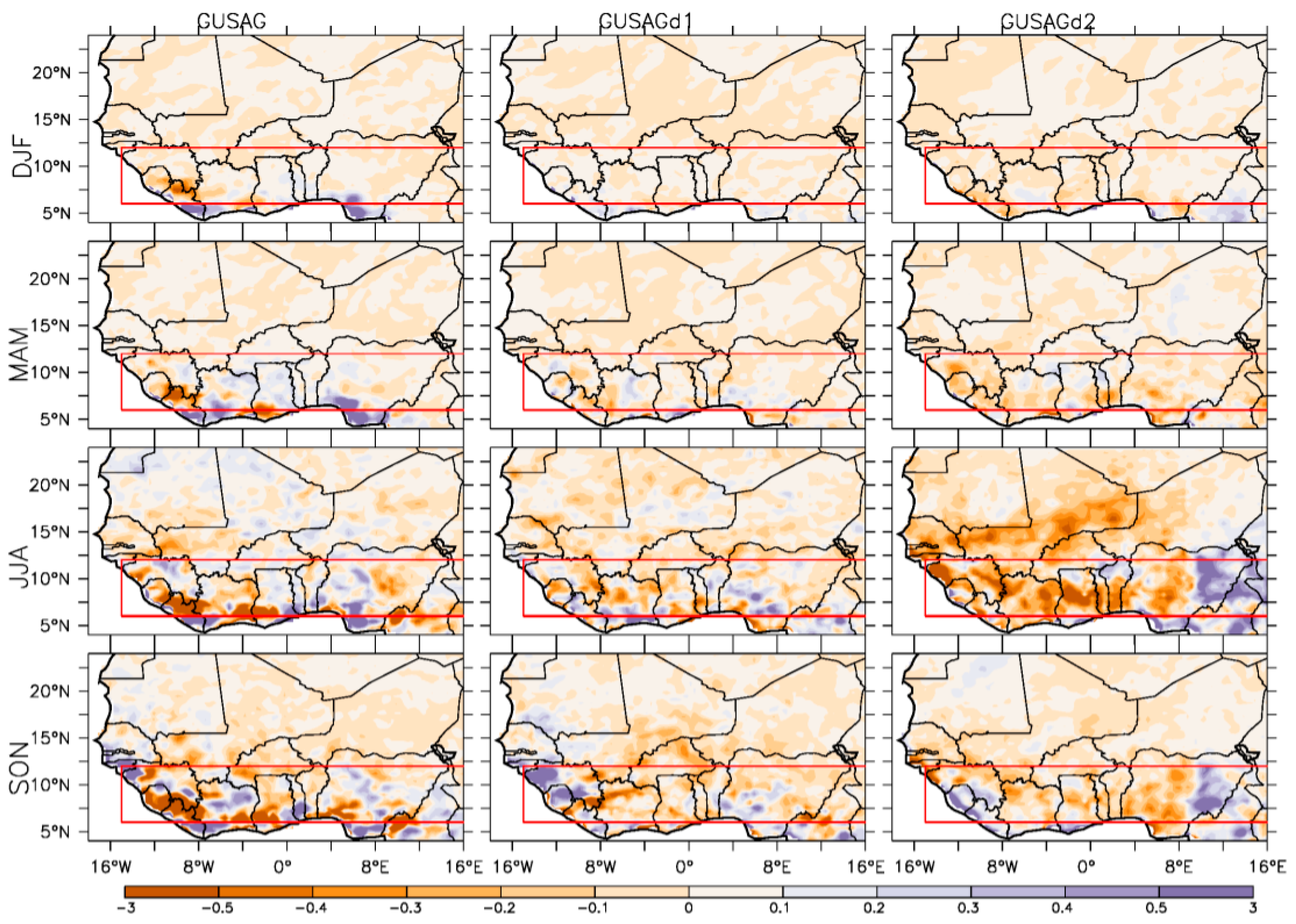
| Plant Functional Types (PFTs) | Tc Min (°C) | Tc Max (°C) | GDD Min |
|---|---|---|---|
| Tropical broadleaf deciduous tree | 15.5 | No limit | 0 |
| C4 | 15.5 | No limit | 0 |
| C3 | −17.0 | 15.5 | 0 |
| C3 arctic | No limit | −17.0 | 0 |
| Temperate broadleaf deciduous shrub | −17.0 | No limit | 0 |
| Tropical broadleaf evergreen tree | 15.5 | No limit | 0 |
| Model Aspects | Model Options |
|---|---|
| Radiative transfer | Modified CCM3 (Kiehl et al., 1996) |
| Planetary boundary layer (PBL) | Modified Holtslag (Holtslag et al., 1990) |
| Cumulus convection | Grell with Fritsch and Chappell closure scheme over land |
| MIT scheme over the ocean | |
| Resolved scale precipitation | Sub-grid explicit moisture scheme (SUBEX) |
| Land surface scheme | CLM4.5 (prescribed and dynamic vegetation) |
| Ocean fluxes | Zeng ([52]) |
| Initial and boundary conditions data | HadGem2-ES |
| Horizontal grid | 160 × 192 (gridpoint resolution = 50 km) |
| 250 × 192 (CORDEX domain; gridpoint resolution = 50 km) | |
| Vertical layers | 18 levels |
| Analysis period | 1980–2004 (Historical climate) 2030–2054 (Near future: RCP4.5 Scenario) |
| Experiments | Brief Description | Modified PFTs | Modified Zones |
|---|---|---|---|
| PRES | Historical climate simulation (1979–2004) using fixed percentage cover of PFTs (Figure 2a,g) over a smaller Africa domain (Figure 1a). | None | None |
| PRESd1 | A similar experiment as PRES, but with the activation of dynamic vegetation. Hence, the establishment or survival of the model’s default PFTs (Figure 2a,g) depends on the fulfillment of the conditions in Table 1. | None | None |
| PRESd2 | A similar experiment as PRESd1 but integrated over a larger CORDEX-Africa domain (Figure 1b). | None | None |
| FUTU | Future climate simulation (2029–2054; RCP4.5) using fixed percentage cover of PFTs (Figure 2a,g) over smaller Africa domain. | None | None |
| FUTUd1 | A similar experiment as FUTU but activates dynamic vegetation capability of the model according to the conditions presented in Table 1. | None | None |
| FUTUd2 | A similar experiment as FUTUd1 but integrated over a larger CORDEX-Africa domain. | None | None |
| GUSAG | Future climate simulation (2029–2054) using fixed percentage cover of the PFTs in Figure 3b,d,f over smaller Africa domain. The modification of the PFTs occurs along West Africa Guinea Savanna zone. | The percentage cover of broadleaf deciduous trees, C4, and C3 grasses are modified and fixed at 30%, 60%, and 10%, respectively. | 6° N to 12° N; 15° W to 20° E |
| GUSAGd1 | A similar experiment as GUSAG but with the activation of dynamic vegetation according to the conditions in Table 1. | The initial percentage cover of broadleaf deciduous trees, C4, and C3 grasses are at 30%, 60%, and 10%, respectively. | 6° N to 12° N; 15° W to 20° E |
| GUSAGd2 | A similar experiment as GUSAGd1 but integrated over a larger CORDEX-Africa domain. | The initial percentage cover of broadleaf deciduous trees, C4, and C3 grasses are at 30%, 60%, and 10%, respectively. | 6° N to 12° N; 15° W to 20° E |
© 2018 by the authors. Licensee MDPI, Basel, Switzerland. This article is an open access article distributed under the terms and conditions of the Creative Commons Attribution (CC BY) license (http://creativecommons.org/licenses/by/4.0/).
Share and Cite
Olusegun, C.F.; Oguntunde, P.G.; Gbobaniyi, E.O. Simulating the Impacts of Tree, C3, and C4 Plant Functional Types on the Future Climate of West Africa. Climate 2018, 6, 35. https://doi.org/10.3390/cli6020035
Olusegun CF, Oguntunde PG, Gbobaniyi EO. Simulating the Impacts of Tree, C3, and C4 Plant Functional Types on the Future Climate of West Africa. Climate. 2018; 6(2):35. https://doi.org/10.3390/cli6020035
Chicago/Turabian StyleOlusegun, Christiana Funmilola, Philip G. Oguntunde, and Emiola O. Gbobaniyi. 2018. "Simulating the Impacts of Tree, C3, and C4 Plant Functional Types on the Future Climate of West Africa" Climate 6, no. 2: 35. https://doi.org/10.3390/cli6020035
APA StyleOlusegun, C. F., Oguntunde, P. G., & Gbobaniyi, E. O. (2018). Simulating the Impacts of Tree, C3, and C4 Plant Functional Types on the Future Climate of West Africa. Climate, 6(2), 35. https://doi.org/10.3390/cli6020035





